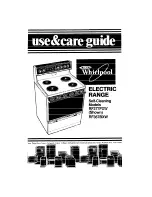
22
How it operates:
Whenever the range is connected to electrical power,
low voltage from the mother board is applied across the
two outside pins of the potentiometers. The
microprocessor then reads the resistance of the
potentiometers. When the switch knob is depressed
and turned the wipe arm attached to the center pin of the
potentiometer is turned to a resistance range that the
microprocessor can read. The microprocessor then
compares these two readings and displays the setting
in the UIB display window for that element. To prevent
the microprocessor from reading a short or an open, a
fixed resistance is connected to each end of the
adjustable resistor internally. The 10,000 Ohm
potentiometer has a 500 Ohm resistance on each end of
the winding and the 20,000 Ohm potentiometer has a
1,000 Ohm resistance on each end of the winding.
The setting display in the UIB display window will read
from Hi to Lo with numbers in between (see chart below).
The microprocessor operates on a 15 second duty cycle.
When the knob is turned to the HI position the mother
board applies line to line voltage to the element all the
time. In any other setting other than Hi the
microprocessor will cycle line to line voltage to the element
by opening and closing the relay on the mother board for
that element.
Display % Of
Display
% Of
Reading On Time Reading On Time
Lo
1
4.0
35
1.0
2
4.5
40
1.2
3
5.0
45
1.4
4
5.5
50
1.6
5
6.0
60
1.8
6
6.5
70
2.0
8
7.0
75
2.2
10
7.5
80
2.4
12
8.0
85
2.6
15
8.5
90
2.8
20
9.0
95
3.0
25
Hi
100
3.5
30
NOTE:
On glass top ranges the element may cycle in
the Hi position because of the limiter in the
element that protects the glass.
NOTE
: In the Lo position a 2500 watt element would
be operating at 25 watts.
The display is also used as a hot surface indicator on
glass top ranges. The mother board is connected to the
hot surface contacts of the element’s limiter. When the
potentiometer is turned to the off position, and if the hot
surface contacts of the limiter are closed the display will
read HE for hot element until the element cools down
and the hot surface contacts of the limiter opens.
Troubleshooting the ESEC 5:
The ESEC 5 has some self diagnostics built into the
microprocessor to help in troubleshooting the system.
When a failure occurs one of three codes will appear in
all the display windows; F5, F6, or F7.
F5 code:
Indicates a harness, mother board, or user interface
board has failed. The harness is the first thing to check,
unplug the harness, inspect each connection and Ohm
out the harness.
Harness
Bridge
Expandable
Warmer
Small
Top elements
Summary of Contents for NEXT GEN
Page 30: ...30 SAMPLE SCHEMATIC FOR ES100 CONTROL SYSTEM ...
Page 37: ...37 SAMPLE SCHEMATIC FOR THE ES 200 CONTROL SYSTEM ...
Page 46: ...46 SAMPLE SCHEMATIC FOR THE ES 300 CONTROL SYSTEM ...
Page 56: ...56 SAMPLE SCHEMATIC FOR THE ES 400 CONTROL SYSTEM ...
Page 66: ...66 SAMPLE SCHEMATIC FOR THE ES 450 CONTROL SYSTEM ...
Page 87: ...87 NOTES ...
Page 88: ...88 ...
















































